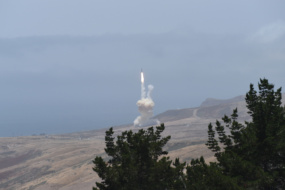The Pentagon’s long-awaited National Defense Strategy warns that conflict in space could quickly spiral out of control without a clear set of norms and expectations.
Released Thursday, the strategy breaks out space concerns primarily into three buckets:
Dangers of escalation
The risk of accidentally escalating a conflict in space is “particularly high due to unclear norms of behavior and escalation thresholds, complex domain interactions, and new capabilities,” the strategy reads. To combat this, the department will analyze “escalation pathways and thresholds,” including planning for how to respond if an attack disrupts comms or situational awareness in orbit.
The lack of norms of behavior in orbit is a concern on Capitol Hill as well. “We really need space doctrine that is administration-proof, regardless of who is in the White House,” Rep. Jim Cooper (D-Tenn.), the chair of the House Armed Services Strategic Forces Subcommittee, told Payload. “If you look at nuclear deterrence doctrine, that is pretty well developed. Space deterrence doctrine is very immature in comparison.” (Look for more from our interview with Cooper next week.)
Resilience
The document codified the DoD’s increasing reliance on constellations of many cheaper, less capable satellites versus buying expensive, huge platforms, something SDA’s Derek Tournear underscored this week when he highlighted how the size of Starlink’s constellation has offered some protection from a Russian attack in the Ukraine war. “Proliferated LEO” is all the rage these days.
The strategy also touched on the Pentagon’s plans for more responsive launch, saying that the military is “increasing options for reconstitution.”
Clear and present
Dangers of space aren’t a future problem, the strategy says. China and Russia are already using counterspace weapons that could target orbital capabilities critical for both military and civilian life, including GPS, which is necessary for everything from credit card transactions to smart bomb navigation.
NDS vs. NSS: We wrote about the White House’s National Security Strategy, which sets a government-wide blueprint, a few weeks ago. The National Defense Strategy is the Pentagon-specific document to back that up.
+ While we’re here: Unfortunately, it was not a great week for in-space saber rattling. A Russian official warned that Western commercial satellites could be shot down if they’re involved in the war in Ukraine, doubling down on threats made last month. The White House didn’t take that well, promising a military response if Russia targeted US or allied space assets.




